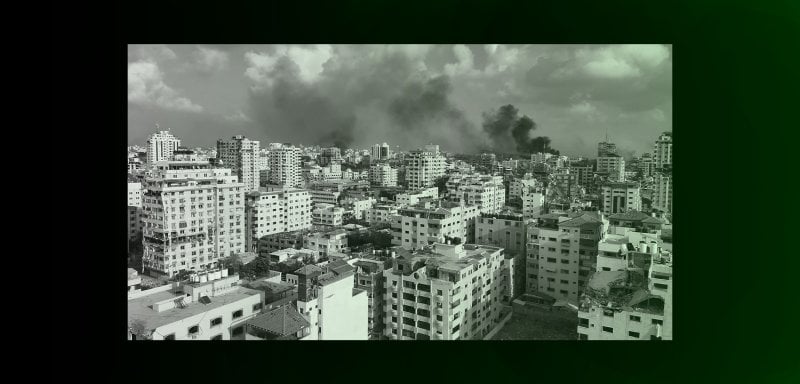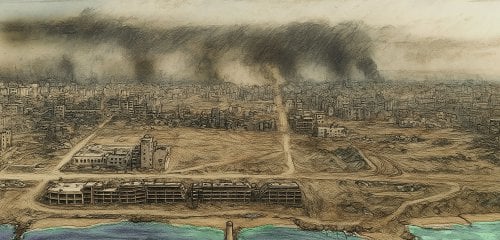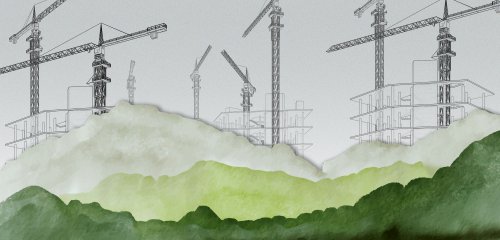Since October 2023, massive explosions from various types of bombs, munitions, and continuous shelling by Israeli aircraft, tanks, and naval vessels have caused lethal air pollution in Palestine. The near-total collapse of the waste management system, disappearance of tree cover, and ongoing colonial-industrial practices have left Palestinians with respiratory, cardiac, and neurological illnesses.
A March 2025 assessment by the United Nations Satellite Center, a body that provides satellite image analysis during humanitarian emergencies, revealed that around 81 percent of agricultural lands in Gaza were destroyed by Israel as a result of systematic bulldozing, the movement of heavy military vehicles, and continuous bombardment.
“Poor air quality overwhelms an already devastated healthcare system. In a place where hospitals and clinics have been destroyed, treating these conditions is nearly impossible. The air in Gaza is now a silent, invisible threat that people cannot escape.”
Although ecological destruction, including the pollution of air, has been used by Israelis as a weapon of warfare since 1948, the aftermath of the genocide is dire. Amid international talks about reconstruction and the UN Security Council’s adoption of President Trump’s Gaza plan, how have emissions affected Palestinian lives?
“When the wind blows the smoke from the bombing—seeping into our homes, shelters, and streets—it smells like gunpowder and fire, or burnt plastic,” Gaza resident Nesrine Sulaiman told Raseef22. Residents’ sense of smell would disappear for hours, only to return with the sharp odor of chlorine or another heavy gas, according to her. Many reported that the irritation lingered, leaving their throats sore for days, sometimes even a week.
“When you try to breathe, every breath feels like hell.”
Air quality amidst a genocide
Chemicals in bombs and munitions contain many heavy metals such as tungsten, cobalt, and lead, which can become aerosolized and inhaled into the lungs. Emissions from the planes and tanks used for bombing include particulate matter (PM₂.₅), nitrogen dioxide (NO₂), carbon monoxide (CO), and unburned hydrocarbons, environmental health scientist Dr. Amira Aker told Raseef22.
“The genocide has impacted air quality in multiple ways,” Aker said.
Large-scale fires and smoke from targeted infrastructure are another major source of air pollution. The combustion of building materials, plastics, fuels, and chemicals releases a toxic plume of smoke containing dioxins, furans, polycyclic aromatic hydrocarbons, and black carbon. In addition, the destruction of buildings creates vast quantities of debris, pulverizing concrete, insulation, and other materials into fine dust. A significant concern here is the release of asbestos from older buildings. When inhaled, asbestos fibers can lead to serious diseases like asbestosis, lung cancer, and mesothelioma, often decades after exposure, Aker explained.
Meanwhile, the destruction of the waste management system under the ongoing Israeli assault has forced residents to create temporary waste dumps near residential areas. More than half a million tons of solid waste have accumulated in the Gaza Strip, resulting in air pollution, outbreaks of skin and respiratory diseases, and the proliferation of insects and rodents, according to a report issued by the Palestinian Central Bureau of Statistics (PCBS) in June 2025. As the waste decomposes, toxic gases are released, exposing over 42 percent of Gaza’s population to serious health risks resulting from these hazardous conditions.
“The occupation is deliberately destroying infrastructure in Gaza, and the sewage system is completely gone. Its current state is disgusting and nauseating,” Sulaiman decried, describing how “most people are now suffering from respiratory illnesses, and eye and skin diseases.” The World Health Organization has identified acute respiratory infections as the most common reportable disease in Gaza in 2025, accounting for approximately 68 percent of reportable disease consultations. Meanwhile, 57 percent of households have reported skin conditions, including rashes and scabies.
The collapse of municipal services has also led to the widespread practice of open-air waste burning. This uncontrolled combustion releases a hazardous mix of pollutants, including particulate matter, dioxins, and volatile organic compounds, according to Aker.
More than half a million tons of solid waste have accumulated in the Gaza Strip, resulting in air pollution, outbreaks of skin and respiratory diseases, and the proliferation of insects and rodents.
Sulaiman also mentioned the lack of availability of cooking gas in Gaza “because of oppression by the [Israeli] occupation.” As a result, residents resort to using firewood, plastic, clothes, and nylon to cook. With vehicle fuel not entering Gaza either, the alternative has become burning plastic, Sulaiman said.
A Global Environmental Change study published in October 2025 documented a distinct surge of pollution, including sharp increases in ultraviolet aerosol and carbon monoxide during war, reflecting severe combustion, and a spike in sulphur dioxide post-war, indicating widespread fuel burning and infrastructure damage.
“We are surprised our lungs still work,” Sulaiman said.
Some of the more immediate consequences of the state of the air quality in Palestine are respiratory outcomes and exacerbations, Aker said. Other impacts include both immediate and long-term cardiometabolic outcomes, adverse birth outcomes, epigenetic changes, cancer, and cognitive outcomes. There is also evidence of epigenetic changes with air pollution exposure, she added.
“Air pollution is one of the leading causes of disease, and that is based on studies of transportation traffic. In Palestine, we have much higher levels of air pollution and an extremely susceptible population because of the extreme stressors they are forced to endure,” Aker pointed out.
Emphasizing how the increase in air pollutants also contributes to a significant decrease in life expectancy, Air Pollution Campaigner at Greenpeace MENA Sarra Ben Abdallah told Raseef22 that the Air Quality Life Index (AQLI) indicates that people living in the most polluted regions of the world lose an average of 2.7 years of life.
“And now Gaza is not far from that,” she said. “Poor air quality […] overwhelms an already devastated healthcare system. In a place where hospitals and clinics have been destroyed, treating these conditions is nearly impossible. The air in Gaza is now a silent, invisible threat that people cannot escape,” Ben Abdallah said.
No green cover and the ‘War on the Climate’
The majority of Gaza’s tree cover—nature’s defense against polluted air—has disappeared, both because of the Israeli assault and because residents logged them for heating and cooking.
The United Nations Satellite Center report highlighted a notable rise in destruction in Khan Younis Governorate, showing an eight percent increase compared to the previous analysis issued in December 2024. Similarly, Rafah Governorate witnessed a sharp escalation in the destruction of farmland, rising from 67 percent to 74 percent, reflecting the rapid and ongoing deterioration of Gaza’s agricultural infrastructure.
Some of the more immediate consequences of the state of the air quality in Palestine are respiratory outcomes and exacerbations. Other impacts include immediate and long-term cardiometabolic, adverse birth, and cognitive outcomes, as well as epigenetic changes and cancer.
Meanwhile, the long-term effects of the Israeli assault on agricultural land within Palestine are profound, as heavy metals and other persistent toxins released into the air eventually settle, contaminating soil and water sources, Aker said. The contamination enters the food chain as crops absorb toxins from the soil and groundwater, leading to bioaccumulation in humans and animals. Further, the heavy metals and debris pollute the soils, killing or weakening crops; they also contaminate the crops, leading to another route of chemical exposure in Palestinians, Aker added.
The environmental destruction also exacerbates the impacts of climate change. The study ‘War on the Climate: A Multitemporal Study of Greenhouse Gas Emissions of the Israel-Gaza Conflict’ attempted to calculate the amount of carbon emissions from 15 months of the genocide. Their findings report that almost two million tonnes of carbon dioxide equivalent (tCO2e) were released into the air as a result of direct war emissions, greater than the annual emissions of 36 individual countries and territories.
Decades of colonial-industrial practices and their impact on Palestine’s air pollution
Severe and deadly air pollution spreads across many of the Palestinian territories occupied since 1967, as well as those occupied since 1948, a source at the Environmental Education Center Palestine (EECP), who requested anonymity, told Raseef22.
Amid the ongoing devastation in Palestine, another dimension of ecological harm is the industrial emissions from Israeli “death factories,” such as those in Geshuri, which represent one of the most striking examples of Israel’s environmental targeting, he stated.
After operating for one year in Telmond village in the West Bank, the plant was shut down by order of the Israeli Supreme Court due to lawsuits over its heavy pollution of the region. However, instead of ceasing operations, the factory was relocated to Tulkarem—on Palestinian land confiscated by force.
By 1989, the extent of environmental devastation became evident: the West Bank’s once-fertile farmlands turned white, and the residents of Tulkarem, whose homes are situated approximately 100 meters away, suffered serious health and environmental effects. The area now hosts more than 12 factories and plants for battery production, metal plating, and other activities.
“These factories deliberately operate only when the wind blows from west to east, to prevent pollution from drifting toward Israeli territory and to protect the health of Israelis, while the harmful emissions spread across Palestinian lands,” the source said.
The pollution from debris and chemical waste has worsened cases of asthma and bronchial inflammation, and further aggravated chronic respiratory diseases such as chronic obstructive pulmonary disease (COPD), intensifying both environmental and public health crises in the region.
Environmental considerations for reconstruction
While a September 2025 report by the United Nations Environment Programme (UNEP) states that there is limited data available within Gaza on air quality both before and during the conflict, the UNEP expects to undertake a field-based assessment of the extent and type of environmental degradation “[a]s soon as security conditions allow and access is granted.”
The amount of time needed to clear air pollution from the genocide depends on the pollutant, the scale of destruction, and how quickly hazardous debris, fires, and waste streams are contained and removed.
“Some particulate pollution will fall out within days or weeks after the ceasefire, but toxic residues in soil and buildings, like heavy metals, PCBs, asbestos, residues from burned plastics and electronics, can persist for years or decades,” Ben Abdallah said.
Reconstruction can’t just mean pouring new concrete over toxic rubble. It must be a thoughtful, environmentally just process that puts the health of the people and the land first. That means a full environmental assessment, safe clearance of debris, remediation, renewable and sustainable rebuilding, continuous air quality monitoring, and a long-term public health program to screen and treat pollution-related illnesses—especially in children—for years to come, she said.
Aker agreed that the environment's recovery to pre-conflict levels is a process that is expected to take decades, if not longer, requiring massive and complex remediation efforts.
Achieving "normal" air quality will not be a passive process; it will require a massive, multi-decade environmental remediation project to manage and safely contain the hazardous debris and contaminated soil, Aker noted, emphasizing the importance of removing the debris “first and foremost.”
Reconstruction can’t just mean pouring new concrete over toxic rubble. It must be a thoughtful, environmentally just process that puts the health of the people and the land first.
Consideration should be given to reducing the carbon intensity of reconstruction, where possible. This may include the recycling of construction materials and the use of low-carbon materials. Then comes the revival of the ecosystem through regenerative agriculture, agroforestry, and making use of and expanding native seed banks.
“Bioremediation efforts will require the use of native plants and fungi, particularly those with capabilities in breaking down heavy metals,” Aker said.
Reflecting on the relationships between wars and ecocide, the EECP source remarked, “To understand the place of the environment in times of bloodshed, it is enough to look around us, after gazing upon the humans silently killed, to see scorched earth, targeted trees, destroyed buildings, and fields sown with landmines,” he said.
“Our human tragedy and the bleeding of humankind also carry dimensions that affect our environment—an environment devastated by all kinds of weapons. This destruction has harmed its trees, plants, and birds, and before all that, it has annihilated the human being, the very foundation of its cultivation,” he said. “Amid genocide, it is essential to talk about everything that concerns humanity and life. Air, as a fundamental element in this equation, cannot be separated from discussions of environmental annihilation.”
Raseef22 is a not for profit entity. Our focus is on quality journalism. Every contribution to the NasRaseef membership goes directly towards journalism production. We stand independent, not accepting corporate sponsorships, sponsored content or political funding.
Support our mission to keep Raseef22 available to all readers by clicking here!
Interested in writing with us? Check our pitch process here!






